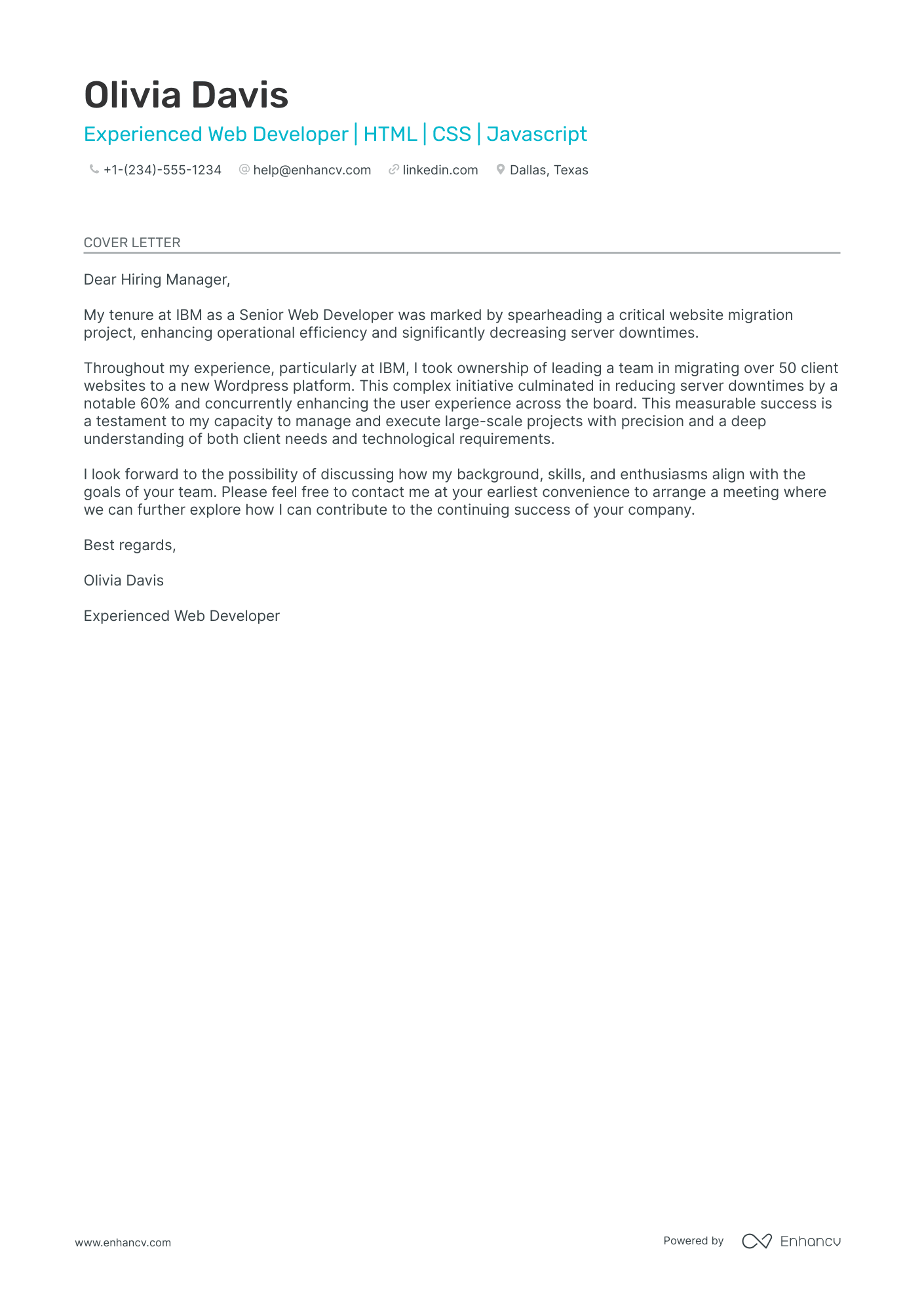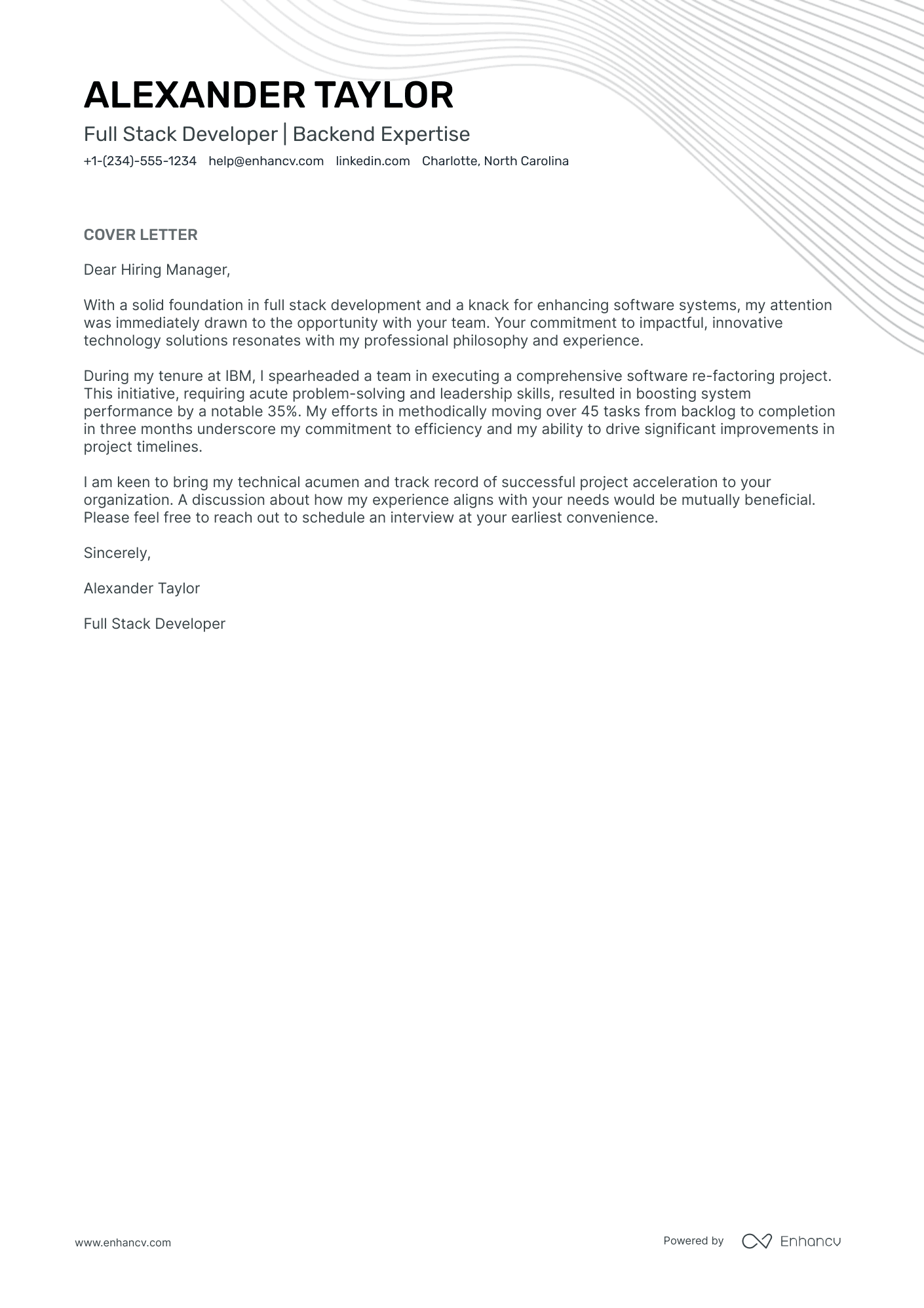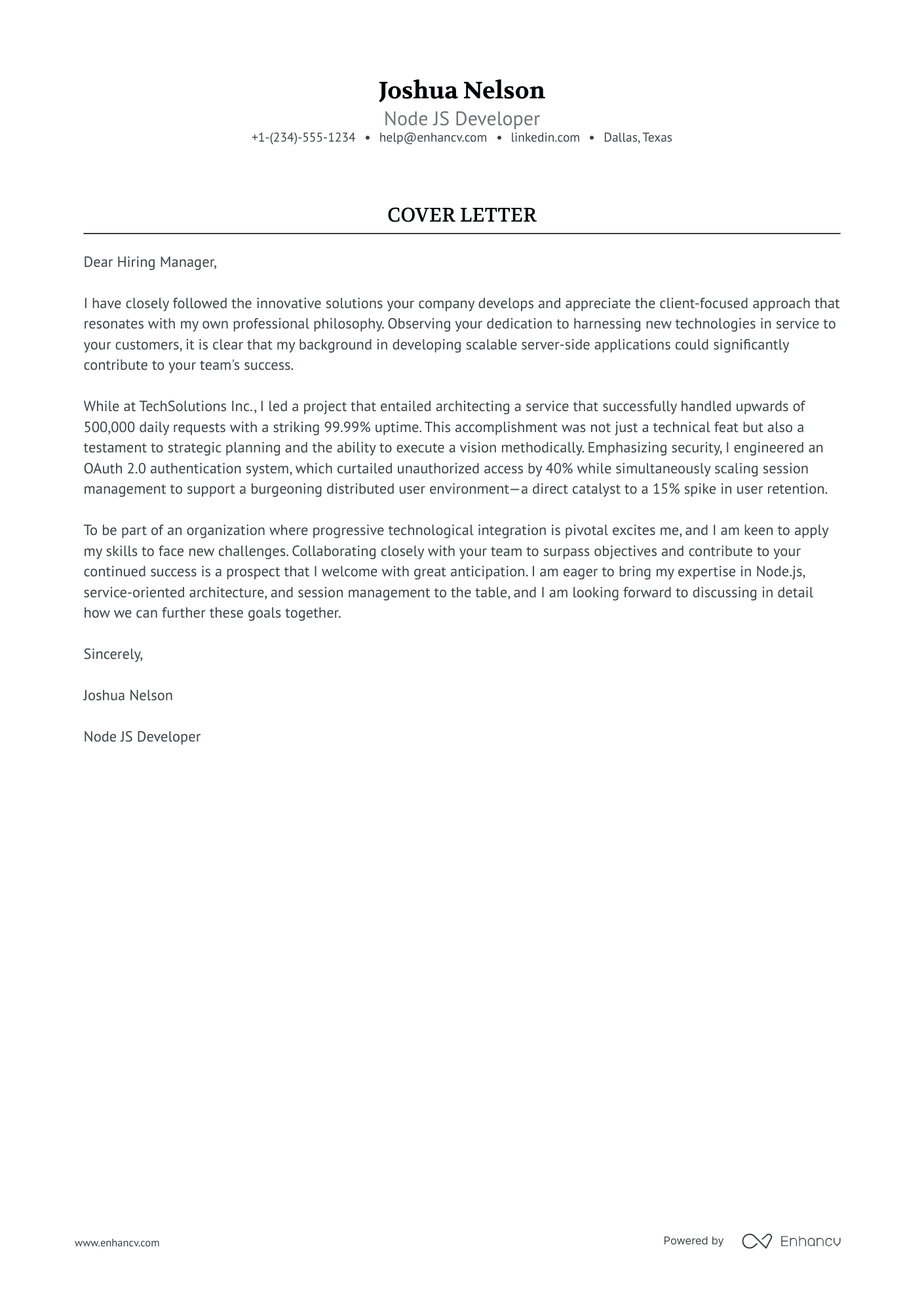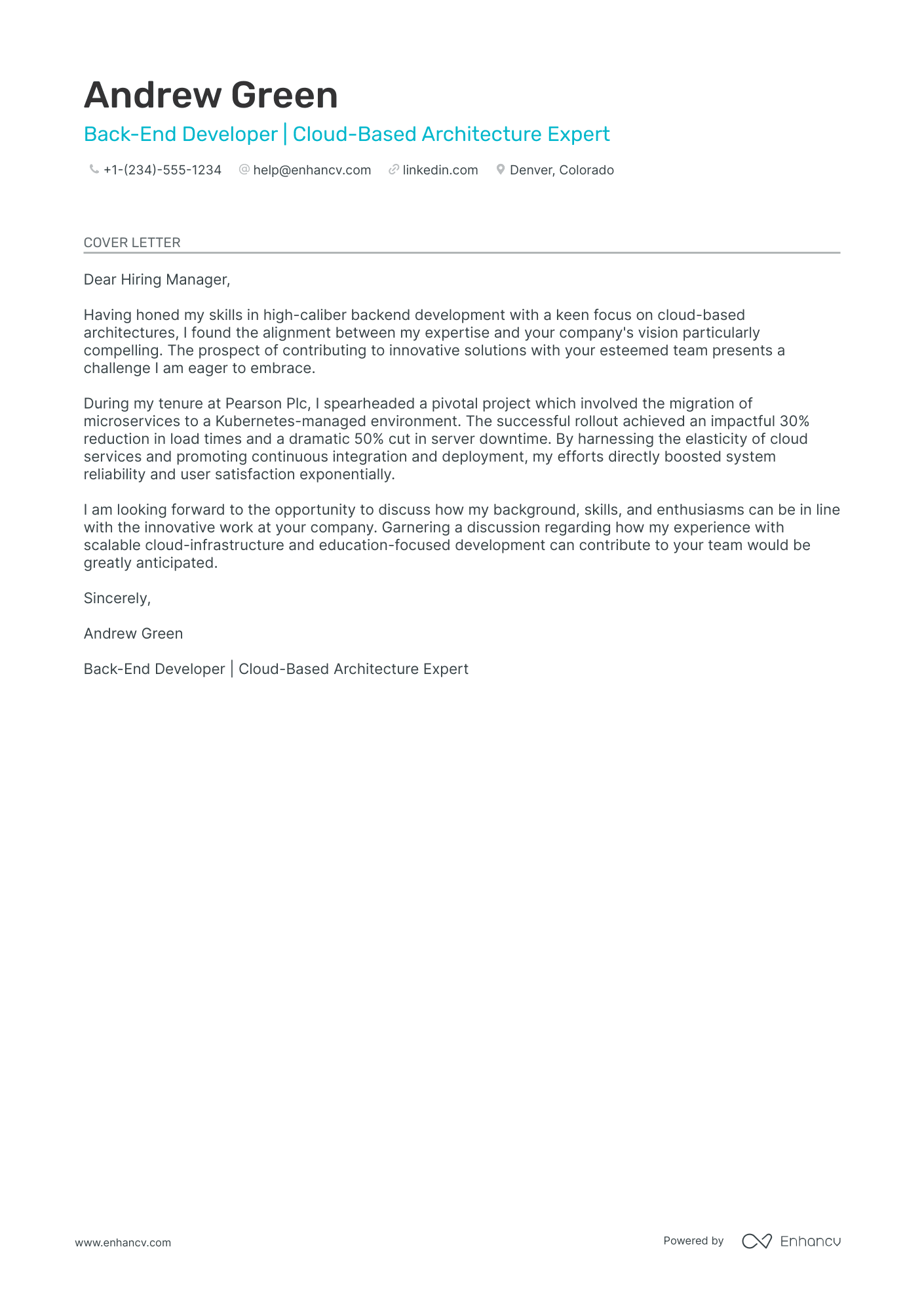Crafting a web developer cover letter can often feel daunting. You're ready to apply for your dream job, and suddenly, you hit a wall: how do you condense your experience into a single page without echoing your resume? Your cover letter should spotlight your crowning professional achievement, weaving it into a compelling narrative that captures attention without leaning on overused phrases. It's a balancing act—formal yet fresh, concise but complete—and it's your key to standing out.
- Making excellent use of job-winning real-life professional cover letters;
- Writing the first paragraphs of your web developer cover letter to get attention and connect with the recruiters - immediately;
- Single out your most noteworthy achievement (even if it's outside your career);
- Get a better understanding of what you must include in your web developer cover letter to land the job.
Let the power of Enhancv's AI work for you: create your web developer cover letter by uploading your resume.
If the web developer isn't exactly the one you're looking for we have a plethora of cover letter examples for jobs like this one:
Drop your resume here or choose a file.
PDF & DOCX only. Max 2MB file size.
Web developer cover letter example
Alex Johnson
New York, NY
+1-(234)-555-1234
help@enhancv.com
- Highlighting proven track records in project delivery and specific achievements, like the development of a custom WordPress theme resulting in a 30% performance improvement, showcases quantifiable success and expertise relevant to the Full Stack Web Developer role.
- Having hands-on experience with advanced web technologies and demonstrating an improvement in team productivity by 20% showcases the ability to work effectively in a team and drive efficiency, which is vital for a collaborative environment.
- Mentioning an alignment with the company's values, such as a commitment to fostering innovation and delivering exceptional digital experiences, strengthens the notion that the candidate is a good cultural fit for the organization.
- The closing paragraph’s call to action, expressing eagerness to discuss the alignment of the candidate's skills with the company’s goals, shows initiative and professionalism, prompting the hiring manager to take the next step.
The visual appeal of your web developer cover letter: format, font, and structure
When using our cover letter builder, make sure to include these vital sections:
- Header (with your name, contact details, the role, and date);
- Greeting (that's personalized to the recruiter);
- Introductory paragraph (to capture attention);
- Body paragraph (to tell a story of how you've obtained your job-crucial skills);
- Closing paragraph (ending with a nod to the future ahead);
- Signature (that is not a must).
Our cover letter templates are already set up for you with the best web developer cover letter design with single-spaced paragraphs and a one-inch margin.
As for the font of your web developer cover letter, use the same one as you did in your resume (where modern and simple fonts, like Rubik and Bitter, take precedence over Arial and Times New Roman).
Your web developer cover letter is created with the recruiters in mind - as no Applicant Tracker System looks over this part of your profile.
When sending over your web developer cover letter, download it in PDF. This format allows your information and design to stay intact and to keep the same visual quality.
Cut down the time spent on cover letters. Use our free cover letter generator to create one in seconds.
The top sections on a web developer cover letter
- Header: Include your contact information, the date, and the employer's details to make it easy for the recruiter to respond to your application and establish professionalism right from the start.
- Opening Greeting: Address the recruiter or the hiring manager directly by name if possible, as personalized greetings can help your cover letter stand out in a sea of generic applications.
- Introduction: Briefly introduce yourself, mention the web developer position you're applying for, and offer a compelling reason why your skills and experiences make you a strong fit for the role, grabbing the reader’s attention immediately.
- Body (Skills and Experience): Provide specific examples of your web development projects, the technologies you are proficient in, and the successful outcomes from your previous roles to demonstrate how you can contribute to the company's objectives and fit into the team.
- Closing and Call to Action: Summarize your enthusiasm for the role, reiterate how your skills will benefit the company, thank the recruiter for their time, and suggest the next steps or express your willingness to discuss your application in more detail during an interview.
Key qualities recruiters search for in a candidate’s cover letter
Proficiency in front-end technologies: Demonstrates the ability to create visually appealing and user-friendly interfaces using HTML, CSS, JavaScript, and popular frameworks/libraries like React or Angular.
Back-end development skills: An understanding of server-side programming languages and frameworks (such as Ruby on Rails, Django, Node.js) highlights the capacity to handle the full stack of web development tasks.
Experience with responsive design: This is critical for ensuring websites function seamlessly across various device sizes, from desktops to mobile phones.
Familiarity with version control systems: Knowledge of tools like Git is essential for collaborating with other developers and managing changes to project codebases efficiently.
Understanding of user experience (UX) principles: The ability to design with the user in mind and improve the usability of a web product is a highly valuable trait in a web developer.
Portfolio of completed projects: Showcasing a variety of web development projects provides tangible evidence of real-world experience and technical competence.
How to address hiring managers in your web developer cover letter greeting
Goodbye, "Dear Sir/Madam" or "To whom it may concern!"
The salutation of your web developer cover letter is how you kick off your professional communication with the hiring managers.
And you want it to start off a bit more personalized and tailored, to catch the recruiters' attention.
Take the time to find out who's recruiting for the role (via LinkedIn or the company page).
If you have previously chatted or emailed the hiring managers, address them on a first or last name basis.
The alternative is a "Dear HR team" or "Dear Hiring Manger", but remember that a "Dear Ms. Simmons" or "Dear Simon," could get you farther ahead than an impersonal greeting.
List of salutations you can use
- Dear Hiring Manager,
- Dear [Company Name] Recruiter,
- Dear [Team Name] Team,
- Dear [Mr./Ms. Last Name],
- Dear [Job Title] Search Committee,
- Dear [Department Name] Department,
The web developer cover letter intro: aligning your interest with the company culture
You only have one chance at making a memorable first impression on recruiters with your web developer cover letter.
Structure your introduction to be precise and to include no more than two sentences.
Here are some ideas on how to write a job-winning web developer cover letter introduction:
- get creative - show off your personality from the get-go (if this aligns with the company culture);
- focus on your motivation - be specific when you say what gets you excited about this opportunity.
What comes next: your web developer cover letter middle paragraphs
In the next three to six paragraphs (or the body of your web developer cover letter) you have to prove your unique value.
Most candidates tend to mess up at this stage. They tend to just copy-paste information from their resume.
That's one big no-no.
Remember that when writing your web developer cover letter, it has to be personalized. And, your ultimate aim is to catch the recruiter's eye.
So, look back on key job requirements and write down a list that includes the ones you cover.
Next, select just one key achievement from your professional (or personal) history that meets those advert keywords.
Narrate a story around how you've grown your skill set and knowledge. Also, aim to show the unique understanding or soft skills you bring about, thanks to your past success.
Ending your web developer cover letter to avoid "sincerely yours"
Yes, this sort of closing statement may work best before your signature.
But you want to give recruiters something more with your web developer cover letter ending.
Some professionals choose to go down the path of promises. In a single sentence, they map out what they'd bring about to the role (whether that's a particular technical skill set or personal traits).
Others, decide to be more concrete by thanking recruiters for their time and prompting for their next interview.
Whatever path you choose, remember to always be polite and respectful of the opportunity you've had. Good manners go a long way.
No experience web developer cover letter: making the most out of your profile
Candidates who happen to have no professional experience use their web developer cover letter to stand out.
Instead of focusing on a professional achievement, aim to quantify all the relevant, transferrable skills from your life experience.
Once again, the best practice to do so would be to select an accomplishment - from your whole career history.
Another option would be to plan out your career goals and objectives: how do you see yourself growing, as a professional, in the next five years, thanks to this opportunity?
Be precise and concise about your dreams, and align them with the company vision.
Key takeaways
We hope this web developer cover letter writing guide has shown you how to:
- Format your web developer cover letter with the mandatory sections (e.g. header, greeting, intro, body, and closing) and select the right font (P.S. It should be the same as the one you've used for your resume);
- Substitute your lack of professional experience with your most noteworthy achievement, outside of work, or your dreams and passions;
- Ensure recruiters have a more personalized experience by tailoring your cover letter not just to the role, but to them (e.g. writing their first/last name in the salutation, etc.);
- Introducing your biggest achievement and the skills it has taught you in your web developer cover letter body;
- Write no more than two sentences in your web developer cover letter introduction to set the right tone from the get-go.
Web Developer cover letter examples
By Experience
Entry-Level Web Developer
By Role




















